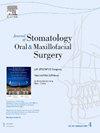前下颌牵张成骨:治疗特发性髁突吸收所致下颌后颌畸形时髁突稳定性的回顾性研究。
IF 2
3区 医学
Q2 DENTISTRY, ORAL SURGERY & MEDICINE
Journal of Stomatology Oral and Maxillofacial Surgery
Pub Date : 2025-04-25
DOI:10.1016/j.jormas.2025.102391
引用次数: 0
摘要
特发性髁突骨吸收(idiopathic condylar reption, ICR)的病因尚不明确,其治疗主要集中于纠正继发性颌面畸形。髁突骨吸收是治疗ICR的常见并发症。牵张成骨术(DO)是治疗特发性髁突吸收(MRSICR)所致下颌后颌畸形的一种方法,可以改善面部轮廓和咬合。然而,尚未准确确定DO是否会对髁状突造成损伤。本实验采用一种创新的治疗方式,将牵引装置由传统的下颌体后位改为前磨牙区,治疗MRSICR,探索一种对颞下颌关节区(TMJ)影响较小的治疗方法。材料和方法:共纳入11例患者(22个髁)。为了模拟牵引方向,术前进行数字化设计。收集患者术前(T0)、术后6个月(T1)、术后1年(T2)、术后3年(T3)影像学资料。评估不同间隔时间TMJ空间距离、表面积、体积、髁平面角度、髁高度的变化。结果:术后髁突的表面积、体积、高度、前后关节间隙距离无明显变化(P < 0.05)。术后关节上间隙变化及髁突横截面位移差异有统计学意义(P < 0.05)。讨论:我们的研究表明,作为MRSICR的一种治疗方法,前下颌DO在避免术后并发症如髁突吸收方面具有一定的优势。未来的研究需要更大的样本量来验证该技术的可行性。本文章由计算机程序翻译,如有差异,请以英文原文为准。
Anterior mandibular distraction osteogenesis: a retrospective study of condylar stability in the treatment of mandibular retrognathia secondary to idiopathic condylar resorption
Introduction
The etiology of idiopathic condylar resorption (ICR) is not conclusively established, and its treatment is primarily focused on correcting secondary maxillofacial deformities. Condylar resorption is a common complication of the treatment of ICR. As one treatment for mandibular retrognathia secondary to idiopathic condylar resorption (MRSICR), distraction osteogenesis (DO) can improve the facial profile and the occlusion. However, it has not been accurately determined whether DO could cause damage to the condyle. In this experiment, one innovative therapeutic modality was used to treat MRSICR by changing the traction device from the traditional posterior position of the mandibular body to the premolar region to explore a treatment method with less impact on the temporomandibular joint area (TMJ).
Materials and methods
A total of 11 patients (22 condyles) were included. To simulate the direction of traction, preoperative digital design was performed. Patients' radiological data were collected preoperatively (T0), six months following surgery (T1), a year following surgery (T2), and three years following surgery (T3). The changes in the distance of the TMJ space and in the surface area, volume, condylar plane angle, and condylar height at different intervals were assessed.
Results
Surface area, volume, height and the distances of anterior and posterior joint spaces of the condyle did not alter significantly after surgery (P > 0.05). Significant differences were found in the postoperative changes in supra-joint space and the condylar displacement in cross-section (P < 0.05).
Discussion
Our study suggests that as a treatment for MRSICR, the DO of the anterior mandible has shown some advantages in avoiding postoperative complications as condylar resorption. Larger sample sizes are required for future research to validate the viability of this technique.
求助全文
通过发布文献求助,成功后即可免费获取论文全文。
去求助
来源期刊

Journal of Stomatology Oral and Maxillofacial Surgery
Surgery, Dentistry, Oral Surgery and Medicine, Otorhinolaryngology and Facial Plastic Surgery
CiteScore
2.30
自引率
9.10%
发文量
0
审稿时长
23 days
 求助内容:
求助内容: 应助结果提醒方式:
应助结果提醒方式:


